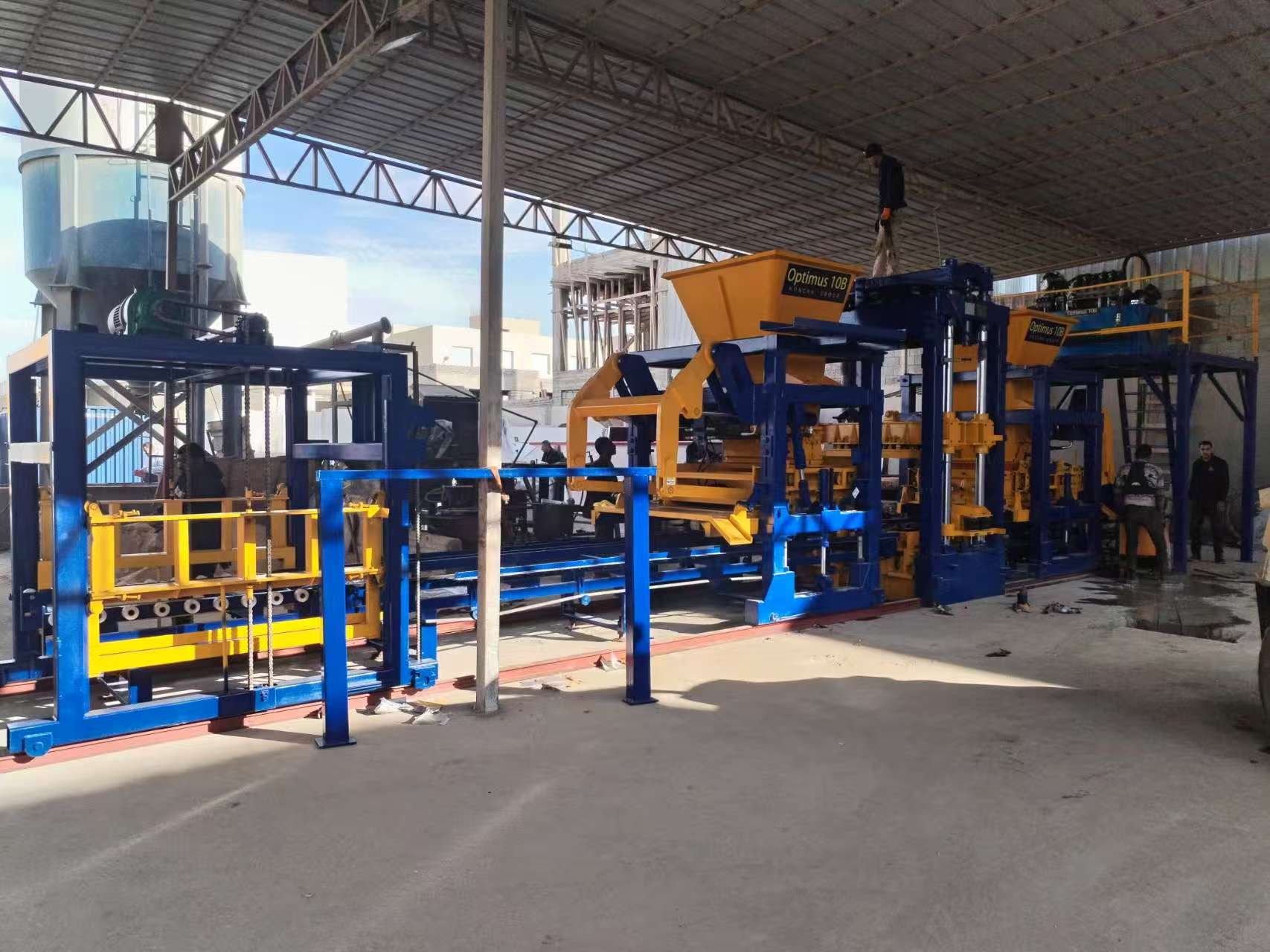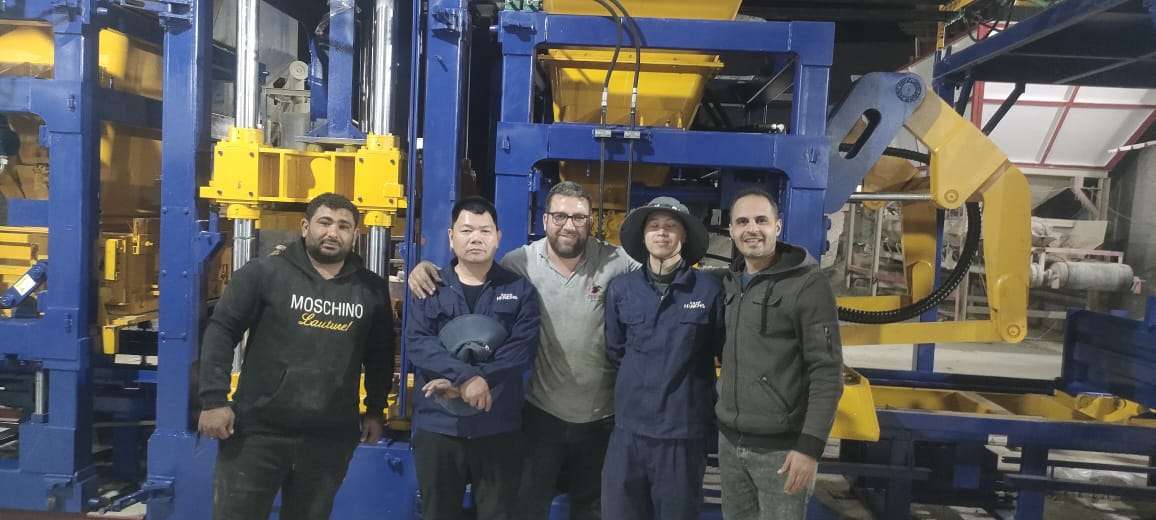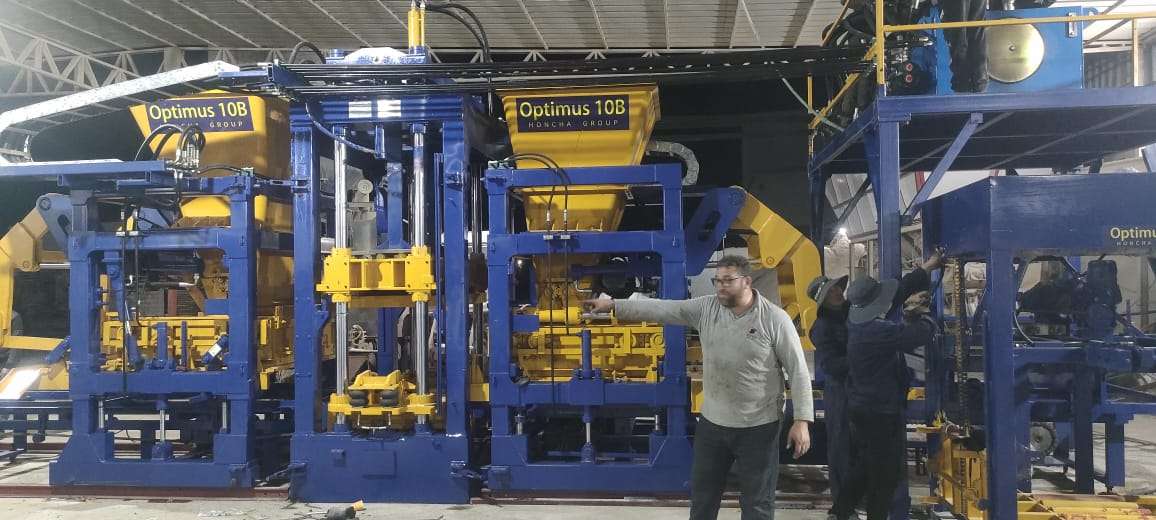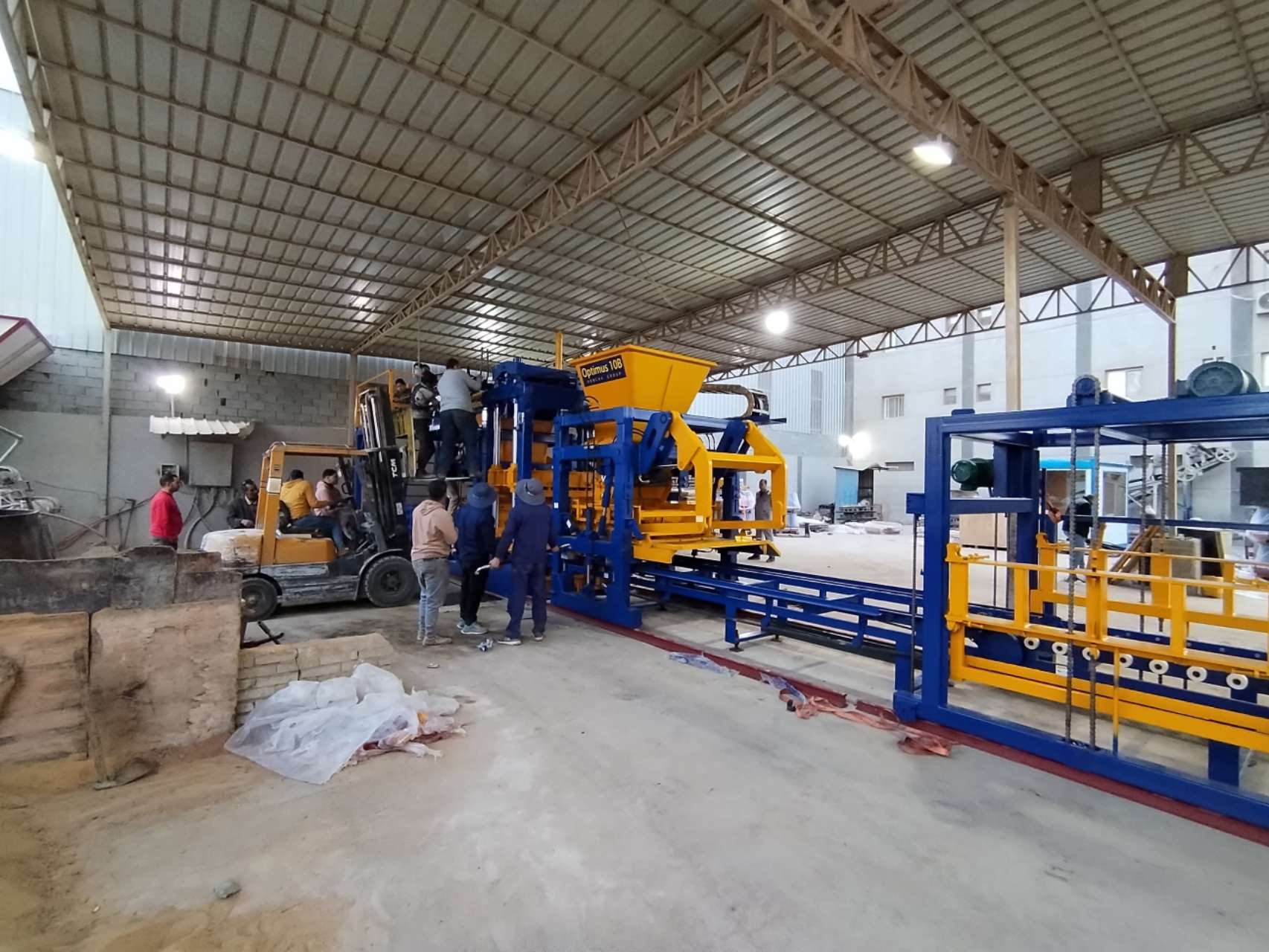I. Equipment Overview
The picture shows an automatic block molding machine, which is widely used in the production field of building materials. It can process raw materials such as cement, sand and gravel, and fly ash through precise proportioning and pressing to produce various blocks, such as standard bricks, hollow bricks, and pavement bricks, meeting the needs of different construction projects and facilitating the efficient and environmentally friendly production of wall and ground materials.
II. Structure and Composition
(1) Raw Material Supply System
The yellow hopper is the core component, responsible for storing and conveying raw materials. Its large-capacity design can continuously supply materials for subsequent processes. Equipped with a precise feeding device, it can stably output mixed raw materials such as sand and gravel, and cement according to the preset proportion, ensuring the uniformity of the composition of block raw materials.
(2) Molding Main Machine System
The main body has a blue frame structure, which is the key to block molding. It has built-in high-strength molds and pressing mechanisms, and applies high pressure to the raw materials through hydraulic or mechanical transmission. The molds can be replaced as needed to adapt to various specifications such as standard bricks and hollow bricks. The pressure and stroke are precisely controlled during the pressing process to ensure the compactness and dimensional accuracy of the blocks and improve product quality.
(3) Conveying and Auxiliary System
The blue conveying frame and auxiliary devices are responsible for the transportation of raw materials and finished products. From the raw materials entering the hopper to the formed blocks being transported to the designated area, the whole process is automated. Cooperating with auxiliary mechanisms such as positioning and flipping, it ensures the continuity of production, reduces manual intervention, and improves efficiency.
III. Working Process
1. Raw Material Preparation: Cement, sand and gravel, fly ash, etc. are mixed evenly according to the formula and conveyed to the hopper of the raw material supply system.
2. Feeding and Pressing: The hopper accurately feeds the material to the molding main machine, and the pressing mechanism of the main machine starts to apply pressure to the raw material according to the set parameters (pressure, time, etc.) for molding, and quickly completes the initial shape formation of the block.
3. Finished Product Conveying: The formed blocks are conveyed to the curing area or directly palletized through the conveying system, entering the subsequent curing and packaging links, realizing an automated production closed loop from raw materials to finished products.
IV. Performance Advantages
(1) Efficient Production
With a high degree of automation, each process runs continuously, and block molding can be completed frequently, greatly increasing the output per unit time, meeting the building material supply needs of large-scale construction projects, and helping enterprises improve production efficiency and capacity.
(2) High-Quality Products
By precisely controlling the raw material proportion and pressing parameters, the produced blocks have regular dimensions, up-to-standard strength, and good appearance. Whether it is load-bearing bricks for wall masonry or permeable bricks for ground paving, the quality can be guaranteed, reducing problems caused by building material defects in the construction process.
(3) Environmental Protection and Energy Conservation
Rationally utilize industrial wastes such as fly ash to realize resource recycling, reduce raw material costs and environmental pressure. During the operation of the equipment, energy consumption is reduced by optimizing the transmission and pressing processes, which conforms to the concept of green building material production and helps enterprises practice environmentally friendly production.
(4) Flexible Adaptation
The molds can be replaced conveniently, and it can quickly switch to produce blocks of different specifications and types, adapting to the needs of various construction scenarios such as residential, municipal, and garden projects, making the production of enterprises more flexible and able to respond to diversified market orders.
V. Application Scenarios
In building material production plants, it can mass-produce standard bricks and hollow bricks to supply building masonry projects; in municipal engineering, it can produce permeable bricks and slope protection bricks for road, park, and river slope protection construction; it can also be used in small prefabricated component factories to customize special-shaped bricks to meet the personalized needs of characteristic buildings and landscape projects, providing key equipment support for the construction industry chain.
In conclusion, with its complete structure, efficient process, and excellent performance, this automatic block molding machine has become a core equipment in the production process of building materials, helping enterprises reduce costs, increase efficiency, and achieve green production, and promoting the high-quality development of the construction industry.
Introduction to the Automatic Block Molding Machine
The picture shows an automatic block molding machine, which is widely used in the production of building materials. It can process raw materials such as cement, sand and gravel, and fly ash through precise proportioning and pressing to produce various blocks like standard bricks, hollow bricks, and pavement bricks, meeting the needs of different construction projects for the efficient and environmentally friendly production of wall and ground materials.
The machine consists of a raw material supply system, a molding main machine, and a conveying and auxiliary system. The yellow hopper is the core of the raw material supply. Its large capacity combined with precise feeding ensures the uniformity of raw materials. The molding main machine with a blue frame uses high-strength molds and a pressing mechanism to accurately control pressure, suitable for producing blocks of multiple specifications and improving quality. The conveying and auxiliary system enables the automatic flow of raw materials and finished products, reducing manual work and ensuring continuous production.
In terms of the working process, first, raw materials are prepared according to the formula and sent into the hopper. After the hopper feeds the materials, the pressing mechanism of the main machine starts, applies pressure for molding according to parameters, and then the finished products are transported to the curing area or palletized through the conveying system, completing an automated closed loop.
It has remarkable performance advantages. Automation ensures efficient production and increases output per unit time. Precise control makes the product dimensions and strength up to standard. Utilizing industrial waste makes it energy-saving and environmentally friendly. Convenient mold replacement adapts to various scenarios and responds flexibly to orders.
It has diverse application scenarios. Building material factories use it to produce standard bricks and hollow bricks; municipal engineering projects use it to make permeable bricks and slope protection bricks; it can also be used in prefabricated component factories to customize special-shaped bricks, providing key support for the construction industry chain, helping enterprises reduce costs, increase efficiency, and achieve green production, and promoting the development of the industry.
Post time: Jun-25-2025

 +86-13599204288
+86-13599204288



